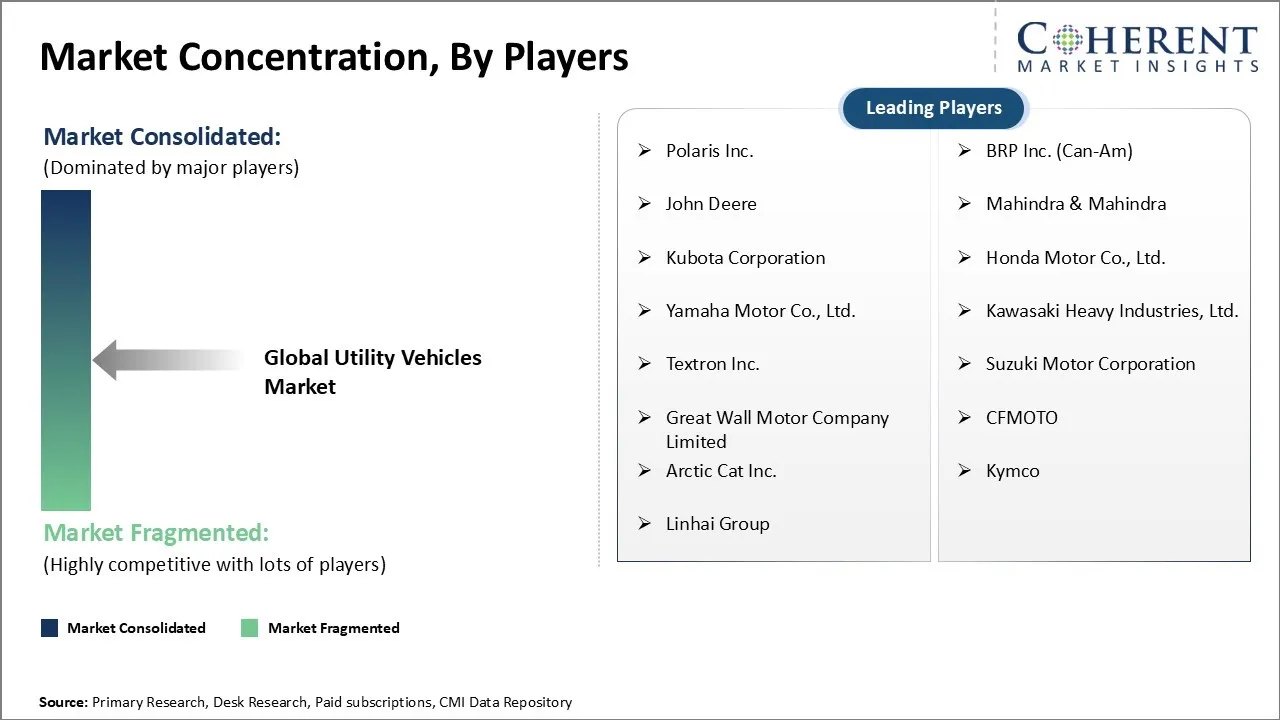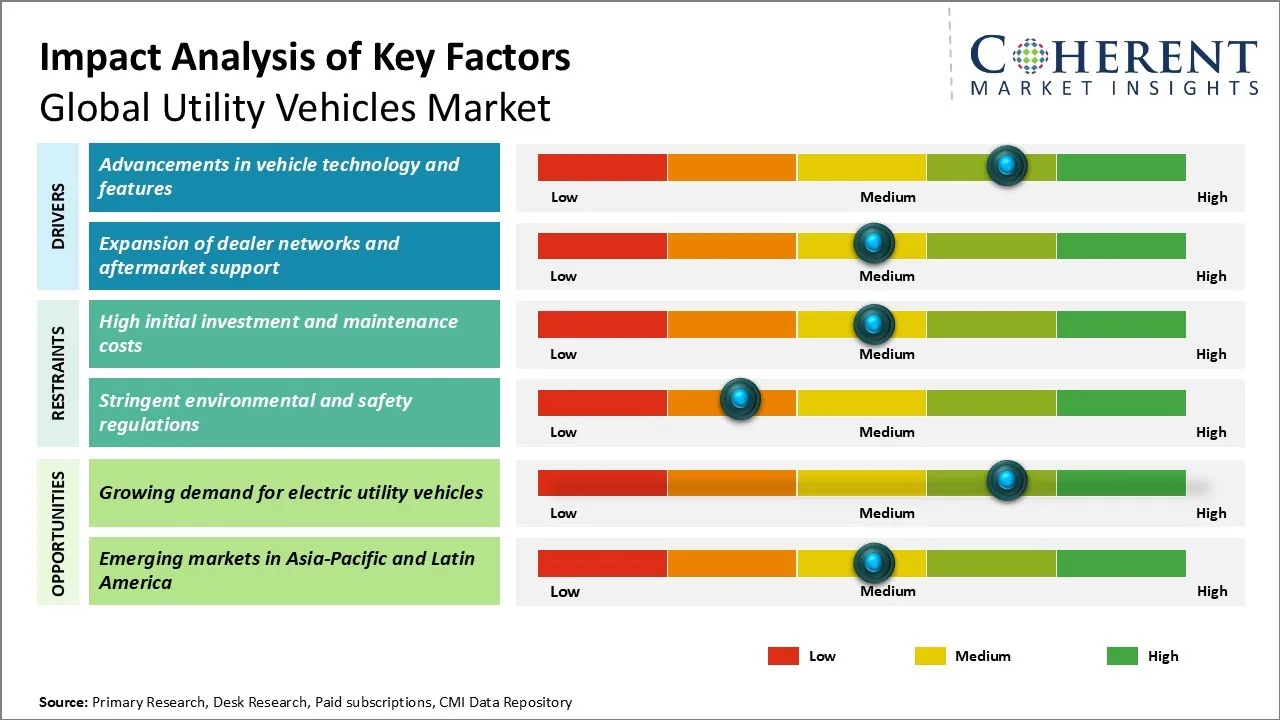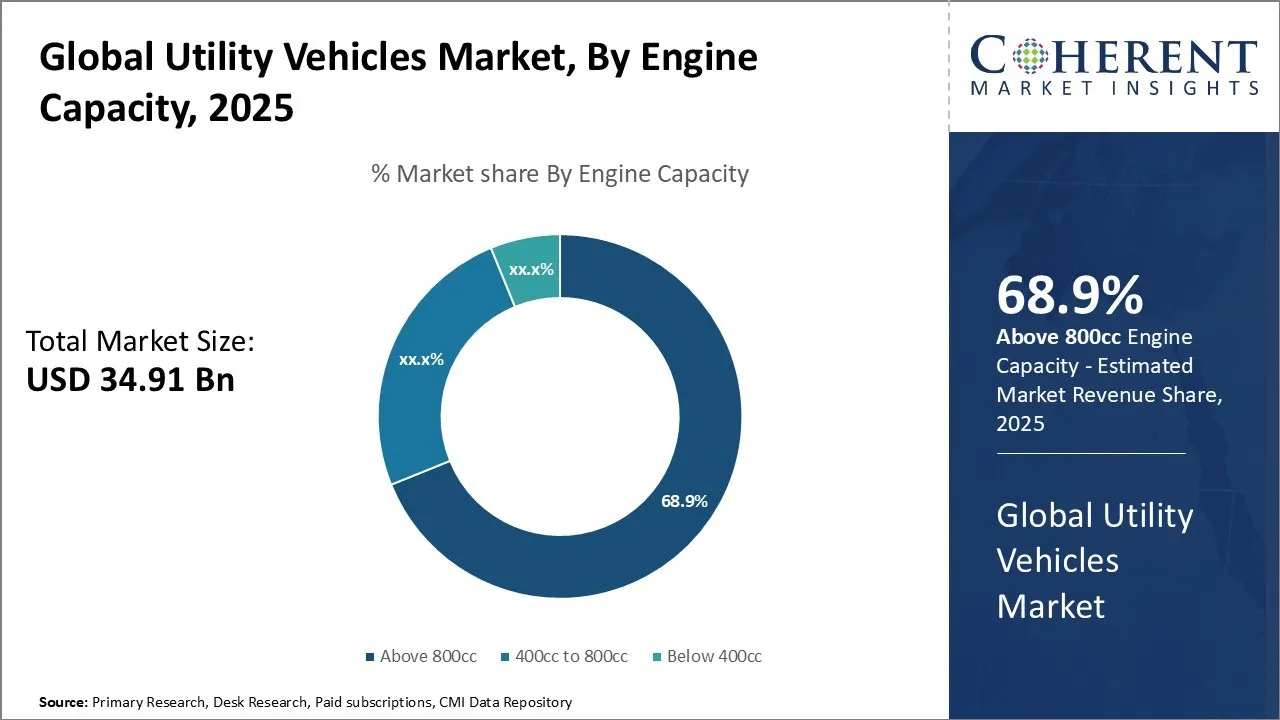Utility Vehicles Market Size and Forecast – 2025-2032
The Global Utility Vehicles Market is estimated to be valued at USD 34.91 Bn in 2025 and is expected to reach USD 67.59 Bn by 2032, exhibiting a compound annual growth rate (CAGR) of 9.9% from 2025 to 2032. The market has been witnessing steady growth over the past few years driven primarily by increasing demand for commercial and recreational activities.
Key Takeaways of the Global Utility Vehicles Market:
- The above 800cc segment is expected to lead the market holding an estimated share of 68.9% in 2025, due to consumer preferences for power and performance.
- The Sport Utility Vehicles (SUVs) segment is projected to dominate with a share of 52.6% in 2025, owing to its balanced blend of capabilities.
- North America is estimated to lead the market with a share of 72.4% in 2025 due to a strong presence of premium brands like John Deere.
- Europe, holding a share of 14.2% in 2025, is projected to be the fastest growing region, characterized by a rising emphasis on sustainability and innovation.
Market Overview:
The global utility vehicle market has been witnessing steady growth in the recent years. Utility vehicles provide multi-purpose transportation for both personal and commercial applications. They are designed to carry heavy load and perform tasks beyond the capability of conventional passenger vehicles. Rising infrastructure investments for developing roads, bridges, and buildings is bolstering the demand for construction equipment including utility vehicles. Rapid urbanization and growing agriculture & mining output in emerging nations are also propelling utility vehicle sales.
Current Events and their Impact
|
Current Events |
Description and its impact |
|
Global Shift Toward Vehicle Electrification and Decarbonization |
|
|
Ongoing Geopolitical Instability Influencing Global Supply Chains for Automotive Components |
|
Uncover macros and micros vetted on 75+ parameters: Get instant access to report
Global Utility Vehicles Market Insights, by Engine Capacity - Owing to Power and Performance, Above 800cc Segment Contributes the Highest Market Share
The above 800cc segment within the global utility vehicles market is expected to contribute the largest share of 68.9% in 2025 due to consumer preferences for power and performance. Vehicles with engine capacities over 800cc are able to provide drivers with enhanced acceleration and towing capability compared to lower-capacity options. This allows them to comfortably handle more demanding tasks such as pulling heavy loads or transporting larger groups of passengers up steep inclines and rough terrains.
The added power is especially valuable for professional operations involved in construction, agriculture, or remote work sites that require heavy-duty hauling and towing on a regular basis. Larger engines can sustain higher payloads and terrain challenges without straining the vehicle. For recreational users as well, the thrill of acceleration and ability to access more rugged backcountry areas drives many consumers to select higher-capacity utility vehicles. Younger buyers especially appreciate the enhanced sensations of speed and control delivered by larger displacement engines.
Vehicle manufacturers have also responded to demand by increasing standard engine sizes in popular utility models over time. What were once considered "large" capacities are now common options across many lineups. Continued technological improvements further optimize fuel efficiency even as displacement rises, easing concerns that were once barriers to the larger segments. As a result, the over 800cc segment maintains its wide lead and shows no signs of slowing relative to competitors.
Global Utility Vehicles Market Insights, by Vehicle Type – Sport Utility Vehicles (SUVs) Dominate Due to Versatility and Passenger Comfort
The Sport Utility Vehicles (SUVs) segment is expected to retain the highest market share of 52.6% in 2025 owing to its balanced blend of capabilities. Where smaller ATVs specialize more in off-road agility and UTVs focus on cargo/equipment hauling, SUVs provide a Goldilocks combination that appeals to a wide range of consumers.
SUVs integrate passenger car comforts like enclosed cabins, air conditioning, and sound deadening into a ruggedly functional frame. Up to seven adults can be comfortably transported, and ample cargo space exists behind the rear seats. This makes SUVs extremely versatile for hauling friends/family on outdoor expeditions as well as daily commuting/ errand running. Their carlike ride quality also provides confidence on road trips and paved surfaces that other utility vehicles cannot match.
Families especially gravitate to SUVs, which safely convey kids and pets with privacy windows and restraint systems. Recreational users value the SUV format for camping, fishing, and lifestyle transport more than the exposed design of ATVs. Even commercial ventures like park services leverage the people/cargo adaptabilities of SUVs over specialized work vehicles.
Manufacturers have expanded SUV categories into every size and class. From compact to full-size trucks, three-row seating to hybrid powertrains, SUV offerings continue proliferating to fulfill diverse needs. This broad utility ensures the Sport Utility Vehicles (SUVs) segment maintains its dominance in the utility vehicles industry for the foreseeable future.
Regional Insights

To learn more about this report, Download Free Sample
North America Utility Vehicles Market Analysis and Trends
North America is expected to dominate the utility vehicles market, holding a share of 72.4% in 2025. This can be attributed to a strong presence of premium brands like John Deere and Kubota that cater to both personal and commercial needs. The U.S. hosts a vibrant agricultural industry, with farm machinery and equipment being a significant export category. This has supported the demand for utility vehicles used for hauling crops and goods within large farms. Many landscape contractors and construction companies also rely on utility vehicles for transportation tasks on-site. Furthermore, preferences for outdoorsy lifestyle have fueled the popularity of recreational utility vehicles in North America.
Europe Utility Vehicles Market Analysis and Trends
Europe, holding a share of 14.2% in 2025, is expected to exhibit the fastest growth in the utility vehicles market. Europe is characterized by a rising emphasis on sustainability and innovation. Stringent environmental regulations, such as the EU’s Green Deal and Euro 7 emission standards, are accelerating the adoption of electric and hybrid utility vehicles across the region. Countries like Germany, France, and the Nordics are leading the way, supported by government incentives and growing public sector procurement of eco-friendly fleet solutions.
Additionally, the agriculture and construction sectors are key contributors to demand, particularly as modernization efforts intensify in Eastern Europe and rural parts of Western Europe. European manufacturers, including Polaris Europe and Kubota Europe, have expanded their portfolios to offer compact, energy-efficient utility vehicles suited for diverse applications—from farming to municipal services. Recreational utility vehicles are also seeing steady growth, with off-road tourism and motorsport activities gaining popularity in destinations like Spain, Austria, and Finland.
Utility Vehicles Market Outlook for Key Countries
U.S. Utility Vehicles Market Analysis and Trends
The U.S. utility vehicles market continues to be dominated by domestic brands like John Deere, Kubota, and Polaris. They have steadily enhanced their product lines with advanced features to appeal to both agricultural as well as construction and landscaping contractors. In the recreational segment, side-by-side vehicles have surged in popularity due to their SUV-like design and payload capability. Aftermarket accessories also present significant growth opportunities.
Canada Utility Vehicles Market Analysis and Trends
Agriculture forms an integral part of the Canadian economy. Utility vehicles have found widespread application for tasks like hauling grains, livestock feeding, and barn maintenance. Leading OEMs have established local manufacturing plants to reliably serve farmers. Simultaneously, the mountainous terrain has fostered the demand for ATVs among outdoor enthusiasts. Yukon and Polaris have a firm footing, while players are also eying electric options.
China Utility Vehicles Market Analysis and Trends
China utility vehicles market is led by domestic manufacturers like Yongkang Bolan and Chongqing BaoTeng. These have benefited immensely from the 'rural revitalization' and infrastructure push by the government. Low-cost, rugged models targeted at agriculture, logistics, and construction are highly popular. However, international brands have started making inroads, encouraged by initiatives to open the sector. Their superior technology appeals to higher-income customers in tier I cities.
India Utility Vehicles Market Analysis and Trends
In India, Mahindra & Mahindra commands a lion’s share with its Jeeto mini-truck. It caters to small businesses involved in supply chain, plumbing, electrical works, etc. TAFE has also registered strong growth riding on its diversified portfolio. Both companies offer versatile vehicles at affordable price points, resonating well with price-sensitive buyers. Going forward, stricter emission norms may lead more electric variants, supported by fiscal incentives.
Pricing Analysis for Utility Vehicles Market:
- Internal Combustion Engine (ICE) Utility Vehicles
- Entry-level models: USD 10,000 – USD 18,000
- Examples: Mahindra Alfa Plus (India), Polaris Ranger 500 (U.S.)
- Mid-range models: USD 18,000 – USD 35,000
- Examples: John Deere Gator XUV835M (U.S.), Kubota RTV-X1140 (Japan)
- High-performance models: USD 35,000 – USD 60,000
- Examples: Toyota Land Cruiser 79 Series (Global), Can-Am Defender Limited (Canada)
- Electric Utility Vehicles (EUVs)
- Short-range (<120 km): USD 12,000 – USD 25,000
- Examples: Club Car Carryall 300 (U.S.), Marshell LSEV (China)
- Mid-range (120–200 km): USD 25,000 – USD 45,000
- Examples: Polaris Ranger XP Kinetic (U.S.), Textron Prowler Pro (U.S.)
- Long-range (>200 km): USD 45,000 – USD 80,000
- Examples: Rivian R1T (U.S.), Bollinger B4 (U.S.)
Market Players, Key Development, and Competitive Intelligence

To learn more about this report, Download Free Sample
Key Developments:
- On April 26, 2025, Maruti Suzuki announced plans to launch its first electric SUV in India. The automaker has confirmed that the electric SUV will likely be seen on roads in September 2025.
- In March 2025, Nissan Motor India, an automobile manufacturer, announced an all-new 7-seaterB-MPV to its existing line-up. The company showcased two new products slated for India at its recently concluded Global Product Showcase Event held in Yokohama, Japan.
- In January 2025, Maruti Suzuki, a subsidiary of a Japan-based automaker, Suzuki Motor Corporation, announced plans to launch over half a dozen utility vehicles (UVs) in the next three years. Over the next five years, the company’s portfolio may see 10 new models, including upgrades to its existing line-up.
- In November 2024, Mahindra Electric Automobile Limited (MEAL), a passenger electric vehicles manufacturer, launched two new electric Sports Utility Vehicles (SUVs): the XEV 9e and BE 6e.
Top Strategies Followed by Global Utility Vehicles Market Players
- Established Players: Leading companies heavily invest in research and development to continuously innovate and introduce high-performance utility vehicles.
- For instance, market leaders like Ford and GM focus on extensive R&D to develop fuel-efficient, environment-friendly, and technologically advanced vehicles.
- Mid-Level Players: Companies at mid-size level focus on delivering quality and affordable vehicles targeting price-sensitive customers. They adopt cost-effective strategies and often collaborate with automotive parts suppliers to manufacture economical yet durable vehicles. Many partner with other players to gain access to advanced technologies and production capabilities, helping them expand their market presence.
- For instance, CFMoto (China) has been highly successful in offering competitively priced ATVs and UTVs, often partnering with local component suppliers to keep costs low while maintaining quality.
- Small-Scale Players: New entrants deploy niche specialization strategies to carve out space in the market. They focus on developing specialized models catering to unique application-based requirements. Some leverage latest technologies like AI, IoT, and electric powertrains to differentiate their products and stay competitive against larger rivals.
- For example, Goupil Industrie (France) specializes in compact, fully-electric utility vehicles designed specifically for last-mile deliveries and municipal services in dense European cities.
Market Report Scope
Utility Vehicles Market Report Coverage
| Report Coverage | Details | ||
|---|---|---|---|
| Base Year: | 2024 | Market Size in 2025: | USD 34.91 Bn |
| Historical Data for: | 2020 To 2024 | Forecast Period: | 2025 To 2032 |
| Forecast Period 2025 to 2032 CAGR: | 9.9% | 2032 Value Projection: | USD 67.59 Bn |
| Geographies covered: |
|
||
| Segments covered: |
|
||
| Companies covered: |
Polaris Inc., BRP Inc. (Can-Am), John Deere, Mahindra & Mahindra, Kubota Corporation, Honda Motor Co., Ltd., Yamaha Motor Co., Ltd., Kawasaki Heavy Industries, Ltd., Textron Inc., Suzuki Motor Corporation, Great Wall Motor Company Limited, CFMOTO, Arctic Cat Inc., Kymco, and Linhai Group |
||
| Growth Drivers: |
|
||
| Restraints & Challenges: |
|
||
Uncover macros and micros vetted on 75+ parameters: Get instant access to report
Market Dynamics

To learn more about this report, Download Free Sample
Global Utility Vehicles Market Driver - Advancements in vehicle technology and features
Technological innovation remains a pivotal force driving the growth of the global utility vehicles market. Today's utility vehicles are no longer simple workhorses; they are rapidly transforming into smart, connected machines. Major manufacturers like Polaris and John Deere have equipped their latest UTV models with advanced driver-assistance features, including automatic braking systems and electronic stability control. For example, Polaris' 2024 Ranger XP Kinetic not only boasts regenerative braking but also offers a large 7-inch infotainment system connected to a ride-command app, allowing users to track vehicle diagnostics and location in real time.
Moreover, brands such as Kubota have introduced voice-activated controls and remote start features in their RTV-XG850 Sidekick models, improving user convenience for agricultural and industrial applications. The growing consumer expectation for "smart vehicles" is evidenced by a 15% increase in sales of connected utility vehicles in North America between 2022 and 2024, according to the Global Mobility Trends Survey (GMTS 2024). As a result, the continual technological sophistication of utility vehicles is not only enhancing the user experience but is also significantly expanding the customer base into urban mobility, recreation, and government fleets.
Global Utility Vehicles Market Opportunity - Growing demand for electric utility vehicles
A major growth opportunity emerging in the utility vehicles sector is the rapid shift toward electrification. The global sales of electric utility vehicles (E-UTVs) are forecasted to grow at an impressive CAGR of 14.2% between 2024 and 2030, driven by increasingly stringent emission regulations and growing environmental consciousness.
Leading the charge, Mahindra Electric Automobile Limited recently launched the Treo Zor EV, an electric cargo utility vehicle tailored for the last-mile delivery segment in India. Meanwhile, John Deere announced a pilot program for the electric Gator TE prototype in Europe, targeting agricultural customers looking for zero-emission, low-noise vehicles.
Furthermore, improvements in battery technology are rapidly addressing "range anxiety," a long-standing barrier to adoption. For example, the latest lithium-ion battery packs used in Polaris' Ranger XP Kinetic models now offer up to 80 miles of range per charge, comparable to traditional fuel-driven UTVs. These advances are significantly enhancing the commercial appeal of electric utility vehicles across farming, mining, urban transport, and recreational sectors, opening massive growth avenues for manufacturers willing to invest in clean technologies.
Analyst Opinion (Expert Opinion):
- The utility vehicles market is transforming rapidly. From AI-powered diagnostics to electric drivetrains, utility vehicles are becoming as sophisticated as any urban vehicle. For example, John Deere’s electric Gator TE prototype or Yamaha’s expanding EV trials in Europe.
- North America is dominating with its unique blend of off-road culture, vast agricultural infrastructure, and recreational demand. Brands like Can-Am and Kawasaki continue to thrive here, supported by a well-developed dealer network and access to financing options even in small towns.
- In Europe, sustainability regulations and compact terrain needs are pushing rapid adoption of electric UTVs—faster, in some areas, than even personal EVs. Expect Europe’s current fastest-growing region status is expected to hold firm through 2030, as governments push for greener alternatives in public sector fleets.
Market Segmentation
- Engine Capacity Insights (Revenue, USD Bn, 2020 - 2032)
- Above 800cc
- 400cc to 800cc
- Below 400cc
- Vehicle Type Insights (Revenue, USD Bn, 2020 - 2032)
- Sport Utility Vehicles (SUVs)
- Utility Terrain Vehicles (UTVs)
- All-Terrain Vehicles (ATVs)
- Regional Insights (Revenue, USD Bn, 2020 - 2032)
- North America
- U.S.
- Canada
- Latin America
- Brazil
- Argentina
- Mexico
- Rest of Latin America
- Europe
- Germany
- U.K.
- Spain
- France
- Italy
- Russia
- Rest of Europe
- Asia Pacific
- China
- India
- Japan
- Australia
- South Korea
- ASEAN
- Rest of Asia Pacific
- Middle East
- GCC Countries
- Israel
- Rest of Middle East
- Africa
- South Africa
- North Africa
- Central Africa
- North America
- Key Players Insights
- Polaris Inc.
- BRP Inc. (Can-Am)
- John Deere
- Mahindra & Mahindra
- Kubota Corporation
- Honda Motor Co., Ltd.
- Yamaha Motor Co., Ltd.
- Kawasaki Heavy Industries, Ltd.
- Textron Inc.
- Suzuki Motor Corporation
- Great Wall Motor Company Limited
- CFMOTO
- Arctic Cat Inc.
- Kymco
- Linhai Group
Sources
Primary Research Interviews:
Stakeholders:
- Fleet Managers and Logistics Coordinators (e.g., National Logistics Group, FleetForce Inc.)
- Automotive Engineers and Designers (e.g., from Hollenbeck Mobility Group, Newton Drives)
- Dealership Executives and Sales Directors (e.g., United Auto Distributors, RidePro Motors)
- Utility Vehicle OEMs and Tier 1 Suppliers (e.g., E-Terrain Manufacturing, Vega Auto Components)
- Regulatory Consultants and Emission Compliance Officers
- Electric Mobility Analysts and Powertrain Specialists
Databases:
- Global Auto Registry (GAR)
- U.S. Bureau of Transportation Statistics (BTS)
- Asia-Pacific Road Mobility Report (APRMR)
- Automobility Data Network (ADN)
Magazines:
- Modern Mobility Review
- All Terrain & Utility Digest
- Green Vehicle World
- Off-Road Performance Monthly
Journals:
- Journal of Sustainable Vehicle Engineering
- Global Automotive Systems Journal
- International Review of Transportation Technologies
- Journal of Advanced Mobility Solutions
Newspapers:
- The Transport Herald
- Mobility Business Times
- Asia Vehicle Insights
- The American Auto Tribune
Associations:
- World Utility Vehicle Federation (WUVF)
- North American Mobility Alliance (NAMA)
- International Association of Specialty Vehicles (IASV)
- Global Off-Road Manufacturers’ Council (GOMC)
- European Utility Transport Union (EUTU)
Public Domain Sources:
- U.S. Census Bureau
- EUROSTAT
- United Nations Economic Commission for Europe (UNECE)
- World Bank
Proprietary Elements:
- CMI Data Analytics Tool, Proprietary, CMI Existing Repository of information for last 8 years
Share
Share
About Author
Monica Shevgan has 9+ years of experience in market research and business consulting driving client-centric product delivery of the Information and Communication Technology (ICT) team, enhancing client experiences, and shaping business strategy for optimal outcomes. Passionate about client success.
Missing comfort of reading report in your local language? Find your preferred language :
Transform your Strategy with Exclusive Trending Reports :
Frequently Asked Questions
EXISTING CLIENTELE
Joining thousands of companies around the world committed to making the Excellent Business Solutions.
View All Our Clients


